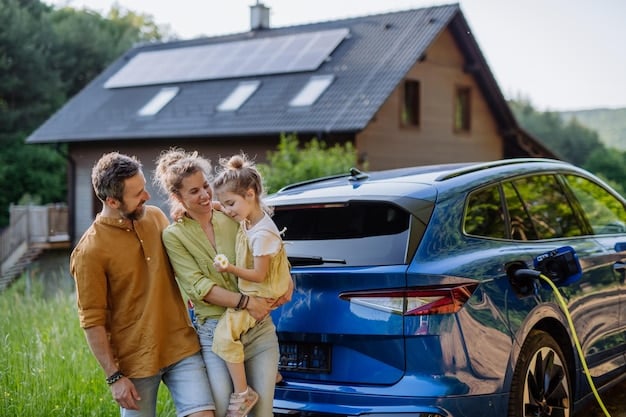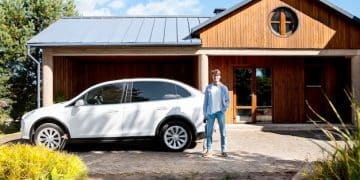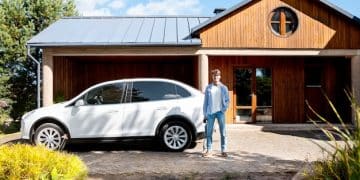New Car Incentives 2025: Maximize Your Savings

New car incentives in 2025 encompass rebates and tax credits aimed at reducing the financial burden of purchasing a new vehicle, requiring careful research and understanding of eligibility criteria to effectively claim these benefits and maximize savings.
Looking to buy a new car in 2025? You might be surprised at the number of opportunities available to save money. New car incentives in 2025: How to Find and Claim Available Rebates and Tax Credits can significantly lower the overall cost, but finding and claiming them requires knowledge and preparation.
New Car Incentives in 2025
Understanding the landscape of new car incentives is crucial for making an informed purchase. These incentives, offered by federal and state governments, as well as manufacturers, can take the form of rebates, tax credits, and other savings. Knowing what’s available can dramatically impact your buying decision.
Keep in mind that eligibility criteria often apply. Factors like income, location, and the type of vehicle purchased all play a role in determining whether you qualify for a particular incentive. Let’s dive into the details.
Understanding Federal Tax Credits for Electric Vehicles
One of the most significant incentives available is the federal tax credit for electric vehicles (EVs). This credit aims to encourage the adoption of cleaner transportation by offering a substantial reduction in the upfront cost of an EV.
How the Federal EV Tax Credit Works
The federal EV tax credit can be up to $7,500, depending on factors such as battery capacity and vehicle assembly location. It’s important to note that this is a non-refundable tax credit, meaning it can only reduce your tax liability to $0, and you won’t receive any of the credit back as a refund.
Income Limitations and Vehicle Eligibility
The Inflation Reduction Act brought significant changes to the EV tax credit, including income limitations for buyers and new requirements for vehicle assembly and battery components. Be sure to check the official IRS guidelines and vehicle eligibility lists to confirm whether you qualify.

State and Local Rebates: Opportunities Beyond Federal Incentives
In addition to federal tax credits, many states and local governments offer their own incentives for new car purchases. These can range from rebates on EVs to tax exemptions for hybrid vehicles.
Researching State-Specific Programs
The availability and value of state and local incentives vary widely. Some states offer generous rebates on EVs, while others provide tax breaks for fuel-efficient vehicles. It’s essential to research what’s available in your specific location.
Stacking Incentives: Maximizing Your Savings
In some cases, it may be possible to “stack” state and local incentives on top of the federal tax credit, further reducing the cost of your new car. However, be aware of any restrictions or limitations that may apply.
Remember to check your local government’s website and resources for any potential incentives they might have.
Manufacturer Rebates and Financing Deals
Automakers often offer their own incentives to attract buyers, including rebates, low-interest financing, and lease deals. These incentives can be a valuable way to save money on a new car, but it’s important to understand the terms and conditions.
Negotiating Rebates and Incentives
Don’t be afraid to negotiate with the dealer to get the best possible price. Rebates and incentives can often be combined with other discounts, but it’s important to do your research and know what’s available.
Comparing Financing Options
Low-interest financing can save you a significant amount of money over the life of the loan, but be sure to compare offers from different lenders and consider the total cost of ownership, including interest and fees.
- Research manufacturer websites for current promotions.
- Compare financing rates from multiple sources.
- Negotiate the final price before applying incentives.
Ultimately, manufacturer rebates can be a solid way to save money on a new car in 2025.
Eligibility Requirements: Who Qualifies for Incentives?
Eligibility requirements for new car incentives vary depending on the program. However, common factors include income limitations, vehicle type, and residency requirements. Understanding these requirements is essential for determining whether you qualify.
Income Limitations and Phase-Outs
Many incentives have income limitations, meaning that higher-income individuals may not be eligible. Some programs also have phase-out periods, gradually reducing the incentive amount as income increases.
Vehicle Type and Fuel Efficiency Standards
Incentives for EVs and hybrids often have specific requirements related to battery capacity, fuel efficiency, and emissions standards. Be sure to check the program guidelines to ensure that the vehicle you’re considering meets the criteria.
Residency Requirements and Location Restrictions
Some incentives are only available to residents of a particular state or locality. Others may have restrictions on where the vehicle can be purchased or registered.

How to Claim Your Incentives: A Step-by-Step Guide
Claiming new car incentives typically involves completing an application and submitting supporting documentation. The process can vary depending on the program, but here’s a general step-by-step guide:
Gathering Required Documentation
Commonly required documents include proof of purchase, vehicle registration, and income verification. Be sure to gather all necessary documentation before starting the application process.
Completing the Application Form
Fill out the application form carefully and accurately. Provide all requested information and double-check for any errors or omissions.
Submitting Your Application and Tracking Progress
Submit your application through the designated channels, such as online portals or mail. Keep track of your application status and follow up if you haven’t received a response within the expected timeframe.
Ultimately, make sure to follow the steps outlined above to claim your incentives.
Tips for Maximizing Your Savings in 2025
To maximize your savings on a new car in 2025, consider the following tips:
Timing Your Purchase
Automakers often offer special promotions and incentives at the end of the year or during major holidays. Timing your purchase to coincide with these events can potentially save you money.
Comparing Offers From Multiple Dealers
Don’t settle for the first offer you receive. Get quotes from multiple dealers and compare prices, incentives, and financing options.
Considering Used EVs and Hybrids
Used EVs and hybrids may also be eligible for incentives, and they often come with a lower price tag than new vehicles. Consider exploring the used market to see if you can find a deal that meets your needs and budget.
- Negotiate the price before discussing incentives.
- Consider leasing for potential tax advantages.
- Explore government and utility company programs.
Hopefully, the tips above help you find a new car that fits your needs while maximizing savings.
In summary, understanding and leveraging new car incentives for 2025 can significantly reduce the financial burden of purchasing a vehicle. By researching available rebates and tax credits from federal, state, and manufacturer sources, potential buyers can navigate the process with informed confidence.
Key Point
Brief Description
💰 EV Tax Credit
Federal incentive up to $7,500 for eligible electric vehicles, subject to income and vehicle requirements.
🌎 State Rebates
Various state-level incentives that can be combined with federal credits to increase savings.
딜 Manufacturer Deals
Rebates and financing offers from automakers, offering cost savings through negotiations.
📝 Eligibility Tips
Check income limits and purchase timing to maximize savings; compare deals from multiple dealers.
Frequently Asked Questions
What is the federal tax credit for electric vehicles in 2025?
The federal tax credit for electric vehicles can be up to $7,500 for eligible new EVs, but it depends on factors like battery capacity and vehicle assembly location. There are also income limitations and vehicle requirements.
How do I find state and local rebates for new cars?
Research the official websites of your state and local government. Look for departments related to energy, environment, or transportation, as they often list available incentives for new car purchases.
Can I combine manufacturer rebates with other incentives?
Yes, in many cases, you can combine manufacturer rebates with federal or state incentives. However, confirm this with the dealer and carefully review the terms and conditions of each incentive.
What documentation do I need to claim new car incentives?
Typically, you’ll need proof of purchase (sales contract), vehicle registration, and income verification. Specific requirements will vary by incentive program, so check the guidelines for each one.
Are there income limitations for new car incentives?
Yes, several incentives have income limitations. The Inflation Reduction Act introduced income caps for the federal EV tax credit, so ensure you meet the requirements to qualify for the full amount.
Conclusion
New car incentives can significantly reduce your costs in 2025 if you stay informed and proactive. Take the time to research all available rebates and tax credits to maximize your savings on a new vehicle.
Read more content





